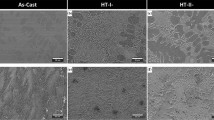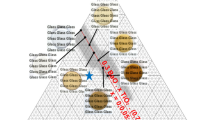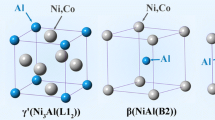Abstract
Starting with Zr of two different purities, Ti-based bulk metallic glasses (BMGs) with a nominal composition of Ti40Zr25Cu12Ni3Be20 were prepared. The effect of the addition of yttrium at levels of 0.2 at.%, 0.4 at.%, 0.5 at.%, 0.6 at.%, and 1 at.% on the glass forming ability (GFA) of the alloy has been investigated by means of metallography, X-ray diffraction, and differential scanning calorimetry. Experimental data indicates that high impurity content dramatically reduces the glass forming ability. Microalloying with 0.5 at.% Y is effective in suppressing the crystalline phase formation and alleviating the detrimental effect of oxygen in the low-purity alloy. On the contrary, in the alloy containing high-purity element, the effective yttrium addition is less than 0.4 at.%. The results indicate that the beneficial effect of the optimum dopants is mainly due to scavenging the oxygen impurity via the formation of innocuous phase.
Similar content being viewed by others
References
Johnson W.L., Bulk glass-forming metallic alloys: science and technology, MRS Bull., 1999, 24: 42.
Inoue A., Stabilization of metallic supercooled liquid and bulk amorphous alloys, Acta Mater., 2000, 48: 279.
Wang W.H., Dong C., and Shek C.H., Bulk metallic glasses, Mater. Sci. Eng. R, 2004, 44: 45.
Gebert A., Eckert J., and Schultz L., Effect of oxygen on phase formation and thermal stability of slowly cooled Zr65Al7.5Cu17.5Ni10 metallic glass, Acta Mater., 1998, 46: 5475.
Liu C.T., Chisholm M.F., and Miller M.K., Oxygen impurity and microalloying effect in a Zr-based bulk metallic glass alloy, Intermetallics, 2002, 10: 1105.
Lu Z.P., and Liu C.T., Role of minor alloying additions in formation of bulk metallic glasses: a review, J. Mater. Sci., 2004, 39: 3965.
Wang W.H., Roles of minor additions in formation and properties of bulk metallic glasses, Prog. Mater. Sci., 2007, 52: 540.
Lu Z.P., Liu C.T., and Porter W.D., Role of yttrium in glass formation of Fe-based bulk metallic glasses, Appl. Phys. Lett., 2003, 83: 2581.
Ponnambalam V., Poon S.J., and Shiflet G.J., Fe-Mn-Cr-Mo-(Y,Ln)-C-B (Ln = lanthanides) bulk metallic glasses as formable amorphous steel alloys, J. Mater. Res., 2004, 19: 3046.
Zhang Y., Pan M.X., Zhao D.Q., Wang R.J., and Wang W.H., Formation of Zr-based bulk metallic glasses from low purity of materials by yttrium addition, Mater. Trans. JIM, 2000, 41(11): 1427.
Wang W.H., Bia Z.N, Wen P., Zhang Y., Pan M.X., and Zhao D.Q., Role of addition in formation and properties of Zr-based bulk metallic glasses, Intermetallics, 2002, 10: 1249.
Xu D.H., Duan G., and Johnson W.L., Unusual glass-forming ability of bulk amorphous alloys based on ordinary metal copper, Phys. Rev. Lett., 2004, 92: 245504.
Xu X., Chen L.Y., Zhang G.Q., Wang L.N., and Jiang, J.Z., Formation of bulk metallic glasses in Cu45Zr48−x Al7Rex (Re = La, Ce, Nd, Gd and 0 ≤ x≤ 5 at.%), Intermetallic, 2007, 15: 1066.
Zhang T. and Inoue A., Thermal and mechanical properties of Ti-Ni-Cu-Sn amorphous alloys with a wide supercooled liquid region before crystallization, Mater. Trans. JIM, 1998, 39(10): 1001.
Kim Y.C., Kim W.T., and Kim D.H., A development of Ti-based bulk metallic glass, Mater. Sci. Eng. A, 2004, 375: 127.
Guo F., Wang H.J., Poon S. J., and Shiflet G.J., Ductil titanium-based glassy alloy ingots, Appl. Phys. Lett., 2005, 86: 091907.
Lin X.H., Johnson W.L., and Rhim W.K., Effect of oxygen impurity on crystallization of an undercooled bulk glass forming Zr-Ti-Cu-Ni-Al alloy, Mater. Trans. JIM, 1997, 38(5): 473.
Author information
Authors and Affiliations
Corresponding author
Rights and permissions
About this article
Cite this article
Hao, G., Ren, F., Zhang, Y. et al. Role of yttrium in glass formation of Ti-based bulk metallic glasses. Rare Metals 28, 68–71 (2009). https://doi.org/10.1007/s12598-009-0013-7
Received:
Revised:
Accepted:
Published:
Issue Date:
DOI: https://doi.org/10.1007/s12598-009-0013-7




